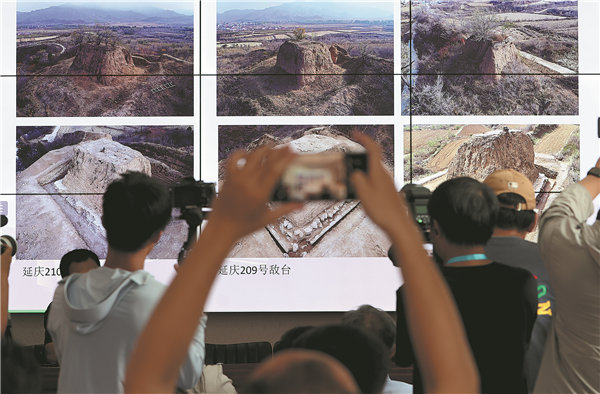

Hebei boasts the Great Wall in different periods, such as those from the Qin (221-206 BC), Han (206 BC-AD 220) and Ming dynasties.
A total of 24 beacon towers on the Fenshuiling section of the Great Wall in Chongli county of the province have been recently studied, and 21 of them didn't reveal Han Dynasty pottery shards (two of them have already been destroyed), Han says.
"The other three beacon towers where Han Dynasty pottery shards were found are relatively low and lack surrounding trenches, while those without Han Dynasty pottery shards are relatively tall and typically have surrounding trenches, which are characteristic of Ming Dynasty beacon towers," Han explains.
Based on the coexistence of artifacts from both the Han and Ming dynasties, it can be inferred that this section of the Great Wall was initially built during the Han Dynasty and later renovated and utilized during the Ming Dynasty, he adds.
"The Han Dynasty beacon towers were either reinforced with additional stones or newly built upon, with surrounding trenches added during the Ming Dynasty renovations," he says.
At the same time, the sections from the Northern Qi Dynasty (550-577) were found in the Haigang district of the province's Qinhuangdao, and continuously arranged beacon towers from the Han Dynasty were uncovered in Chongli.
Han believes the findings will be conducive to the scientific management, protection and research of the Great Wall, enriching its significance and deepening the understanding of it.
Li Yipi, a researcher from the Henan Provincial Institute of Cultural Heritage and Archaeology, expounds on the characteristics and value of the Great Wall of Chu, a vassal state to the Western Zhou Dynasty (c. 11th century-771 BC) dating back more than 2,000 years.
"According to the archaeological excavation findings, the earliest artifacts unearthed within the Chu Great Wall remains date back to the mid-Spring and Autumn Period (770-476 BC)," Li says.
To date, the Chu Great Wall, as recognized by the National Cultural Heritage Administration, is mainly distributed in Pingdingshan, Nanyang and Zhumadian in Henan province. It extends for 383 km and comprises various elements, including artificially constructed long walls, passes, beacon towers, barracks sites and ancient roads, as well as natural mountain passes and rivers, forming an organically unified defensive line.